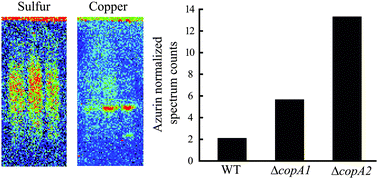Periplasmic response upon disruption of transmembrane Cu transport in Pseudomonas aeruginosa†
Abstract
Pseudomonas aeruginosa, an opportunistic pathogen, has two transmembrane Cu+ transport ATPases, CopA1 and CopA2. Both proteins export cytoplasmic Cu+ into the periplasm and mutation of either gene leads to attenuation of virulence. CopA1 is required for maintaining cytoplasmic copper levels, while CopA2 provides copper for cytochrome c oxidase assembly. We hypothesized that transported Cu+ ions would be directed to their destination via specific periplasmic partners and disruption of transport should affect the periplasmic copper homeostasis. Supporting this, mutation of either ATPase gene led to large increments in periplasmic cuproprotein levels. Toward identifying the proteins participating in this cellular response the periplasmic metalloproteome was resolved in non-denaturing bidimensional gel electrophoresis, followed by X-ray fluorescence visualization and identification by mass-spectrometry. A single spot containing the electron shuttle protein azurin was responsible for the observed increments in cuproprotein contents. In agreement, lack of either Cu+-ATPase induced an increase in azu transcription. This is associated with an increase in the expression of anr and rpoS oxidative stress response regulators, rather than cueR, a copper sensing regulator. We propose that azurin overexpression and accumulation in the periplasm is part of the cellular response to cytoplasmic oxidative stress in P. aeruginosa.


 Please wait while we load your content...
Please wait while we load your content...